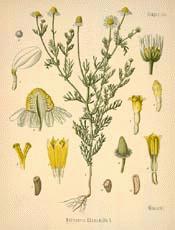Matricaria recutita or German chamomile
Other names include blue chamomile, wild chamomile, Hungarian chamomile, and scented mayweed.
UsesHerbalism
German chamomile is used medicinally against sore stomach, irritable bowel syndrome, and as a gentle sleep aid.
It is also used as a mild laxative. It can be taken as an herbal tea, two teaspoons of dried flower per cup of tea. For a sore stomach, some recommend taking a cup every morning without food for two to three months.
Active ingredients
The primary known active ingredient of the essential oil from German chamomile is the terpene bisabolol. Other active ingredients include chamazulene, flavonoids (including apigenin, quercetin, patuletin and luteolin) and coumarin
 A 2006 review of the medical literature reported a number of beneficial effects for chamomile in in vitro and animal tests, but added that more human clinical trials are needed before firm conclusions can be drawn. Research with animals suggestsantispasmodic, anxiolytic, anti-inflammatory and some antimutagenic and cholesterol-lowering effects for chamomile.
A 2006 review of the medical literature reported a number of beneficial effects for chamomile in in vitro and animal tests, but added that more human clinical trials are needed before firm conclusions can be drawn. Research with animals suggestsantispasmodic, anxiolytic, anti-inflammatory and some antimutagenic and cholesterol-lowering effects for chamomile. Chamomile has sped healing time of wounds in animals. It also showed some benefit in an animal model of diabetes
In vitro chamomile has demonstrated moderate antimicrobial and antioxidant properties and significant antiplatelet activity, as well as preliminary results against cancer
 Essential oil of chamomile was shown to be a promising antiviral agent against herpes simplex virus type 2 (HSV-2) in vitro.
Essential oil of chamomile was shown to be a promising antiviral agent against herpes simplex virus type 2 (HSV-2) in vitro.Potential risks





